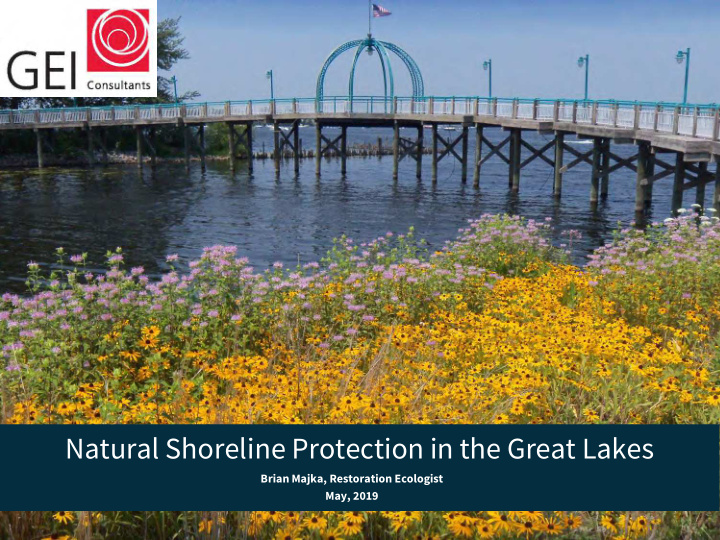



Natural Shoreline Protection in the Great Lakes Brian Majka, Restoration Ecologist May, 2019
Overview • What are natural shorelines? • Design considerations • Project examples from low, moderate, and high energy sites
What is a natural shoreline? • Terminology may change, “natural”, “living”, “nature- based” shorelines • “A living shoreline is a protected, stabilized coastal edge made of natural materials such as plants, sand, or rock. Unlike a concrete seawall or other hard structure, which impede the growth of plants and animals, living shorelines grow over time. “ -NOAA
How does wave energy affect vegetative growth? • Soil erosion • Physical displacement of plants • Turbidity
What do we mean by low/moderate/high energy sites? • Energy is primarily driven by wave height • Wind driven waves • Boats • Wisconsin DNR • Low energy=less than 1 foot • Moderate Energy=1- 2.3’ • High Energy=greater than 2.3’
Bioengineering • Bioengineering is “The use of plants, plant products, and special techniques to create structure within the soil to withstand erosive forces. It involves the reintroduction of deep-rooted native plants, creating a system that mimics naturally stable shorelines.” - MNSP
Stabilization Techniques: A Continuum of Choices Biotechnical Bioengineering Structural Engineering Engineering Rock, gabions, Native plants and Native plants, rock, and natural materials sheetpile, and concrete erosion control materials
Design Considerations • Form MUST follow function • Cost vs. risk Erosive Forces • Aesthetics • Vegetation type • Sunlight • Habitat considerations Regulatory Cultural Issues Ecology (ie, threatened, endangered Concerns or rare species) • Access to site • Soils/moisture Resources • Waves/shear stress/erosive Goals (Time, Money, etc… ) forces
Addison Oaks County Park • Oakland County Park • Conversion of beach into natural shoreline • Low energy
Grand Trunk Public Boat Launch • Owned by MDNR, maintained by City of Muskegon • Low energy • Rock/debris on shoreline Project Location • Project funded by NOAA through the Great Lakes Commission and West Michigan Shoreline Regional Development Commission
Before Restoration
Re-Grading Simple re-grading and debris removal
Heritage Landing County Park • Muskegon County park • Moderate to low energy Project Location • Rock/debris on shoreline • Project funded by NOAA through the Great Lakes Commission and West Michigan Shoreline Regional Development Commission
Project Location
BIO D BLOCK Pre-Restoration
Post-Restoration
BIO D BLOCK Pre-Restoration
BIO D BLOCK Construction
BIO D BLOCK Post-Restoration
BIO D BLOCK Post-Restoration
Post-Restoration
Center Point Bay Marina • Funded by NOAA through the Great Project Location Lakes Commission and WMSRDC • Private landowner • 2 mile fetch • Up to ~3’ ice sheets • ~3’ waves recorded at site • Ice push from multiple directions
2009
2009
2010 Designed gaps for wildlife passage across the land/water interface
Bulrush climbing onto 2015 lake bed
2015
2016
2016 2009
Need to balance • In summary: functional, aesthetic and ecological goals Plants alone may not • cut it Keep the big picture in • mind Consider historic and • future, not just current conditions Remember that a failed • project benefits no one Don’t let the perfect be • the enemy of the good
Thank you! Brian Majka GEI Consultants, Inc. bmajka@ geiconsultants.com 616-843-3635
Recommend
More recommend